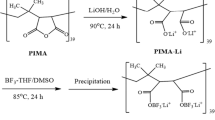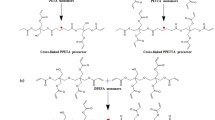Abstract
This paper describes two kinds of elastomeric binders which are styrene–butadiene (ST–BD) copolymer and 2-ethylhexyl acrylate–acrylonitrile (2EHA–AN) copolymer for electrode materials of rechargeable Li-ion batteries. These elastomeric binders were swollen by electrolyte solution (EC/DEC=1/2, 1 M LiPF6), and 2EHA–AN copolymer retained larger amount of electrolyte solution than ST–BD copolymer. The Li-ionic conduction behavior was investigated for both copolymer films swollen by electrolyte solution. The Li-ion conductivity of ST–BD copolymer was 9.45 × 10−8 S·cm−1 and that of 2EHA–AN copolymer was 1.25 × 10−5 S·cm−1 at room temperature, and the corresponding amounts of activation energy were 0.31 and 0.26 eV, respectively. Because the observed activation energy in elastomeric binder was different from that in the bulk of electrolyte solution (0.09 eV), Li-ion conduction of the bulk of elastomeric binder swollen by electrolyte was affected by the polymer structure of binders. Electrochemical performance of cathode material, LiCoO2, was investigated with three kinds of binders: ST–BD copolymer, 2EHA–AN copolymer, and poly(vinylidene fluoride). The initial charge–discharge capacity of the LiCoO2 electrode with 2EHA–AN copolymer showed highest capacity, suggesting that Li+-ion conduction inside of the elastomeric binder contributes to the enhancement of charging and discharging capacity. This result indicates that elastomeric binder with sufficient Li-ionic conductivity can be an attractive candidate for improving cathode of lithium-ion battery.





Similar content being viewed by others
References
Du Pasquier A, Disma F, Bowmer T, Gozdz AS, Amatucci G, Tarascon JM (1998) J Electrochem Soc 145:472
Maleki H, Deng G, Anani A, Howard J (1999) J Electrochem Soc 146:3224
Roth EP et al (2004) J Power Sources 134:222
Lee JH et al (2005) J Electrochem Soc 152:A1763
Buqa H et al (2006) J Power Sources 161(1):617
Kaneko M, Guerfi A, Charest P, Mori M, Zaghi K (2004) 206th meeting of the ECS; extended abstract 412, Honolulu, Hawaii, 7 October 2004
Guerfi A, Kaneko M, Charest P, Mori M, Zaghib K (2006) J Power Sources (in press)
Akashi H, Tanaka K, Sekai K (1998) J Electrochem Soc 145:881
Meyer WH (1998) Adv Mater 10:439
Song JY, Wang YY, Wan CC (1999) J Power Sources 77:183
Osaka T, Liu X, Nojima M, Momma T (1999) J Electrochem Soc 146:1724
Matsuda Y, Morita M, Tsutsumi H (1993) J Power Sources 43/44:439
Reich S, Michaeli I (1975) J Polym Sci Polym Phys Ed 13:9
Watanabe M, Kanda M, Nagaoka K, Shinohara I (1983) J Polym Sci Polym Phys Ed 21:939
Author information
Authors and Affiliations
Corresponding author
Rights and permissions
About this article
Cite this article
Kaneko, M., Nakayama, M. & Wakihara, M. Lithium-ion conduction in elastomeric binder in Li-ion batteries. J Solid State Electrochem 11, 1071–1076 (2007). https://doi.org/10.1007/s10008-006-0239-3
Received:
Revised:
Accepted:
Published:
Issue Date:
DOI: https://doi.org/10.1007/s10008-006-0239-3




